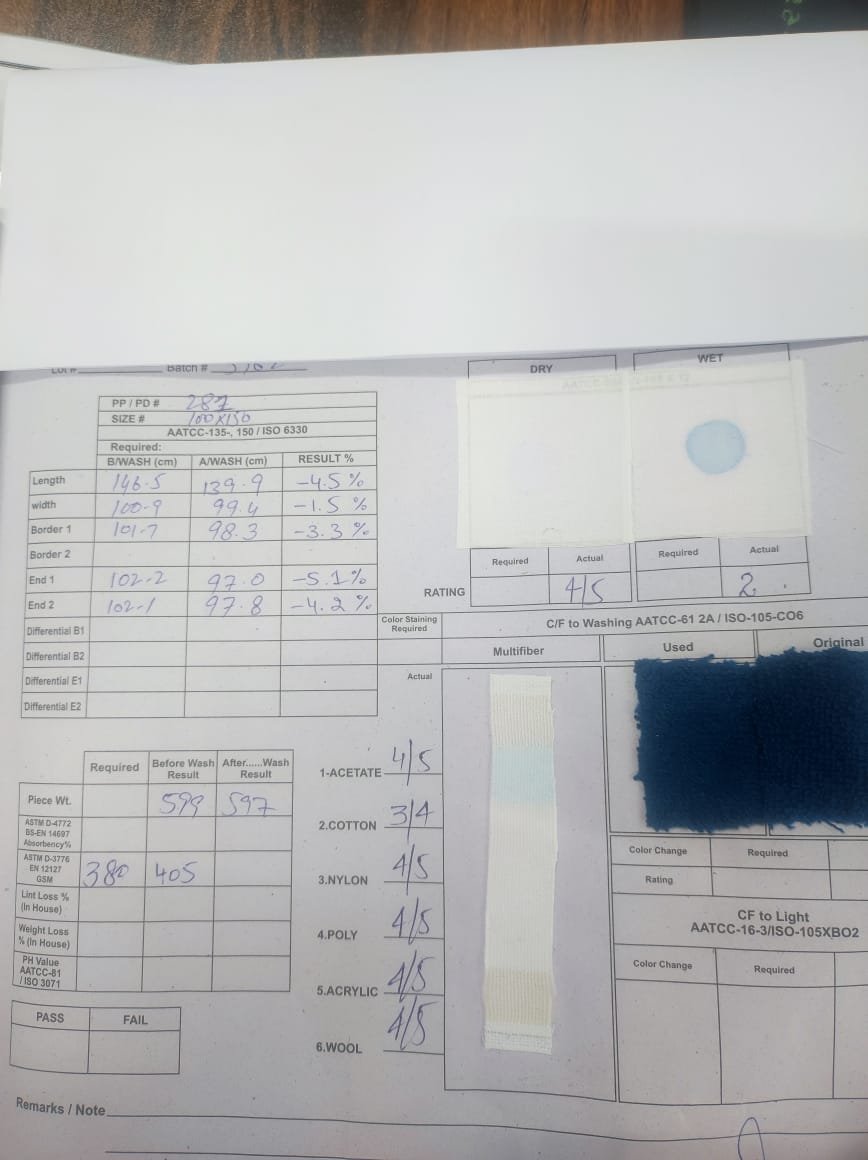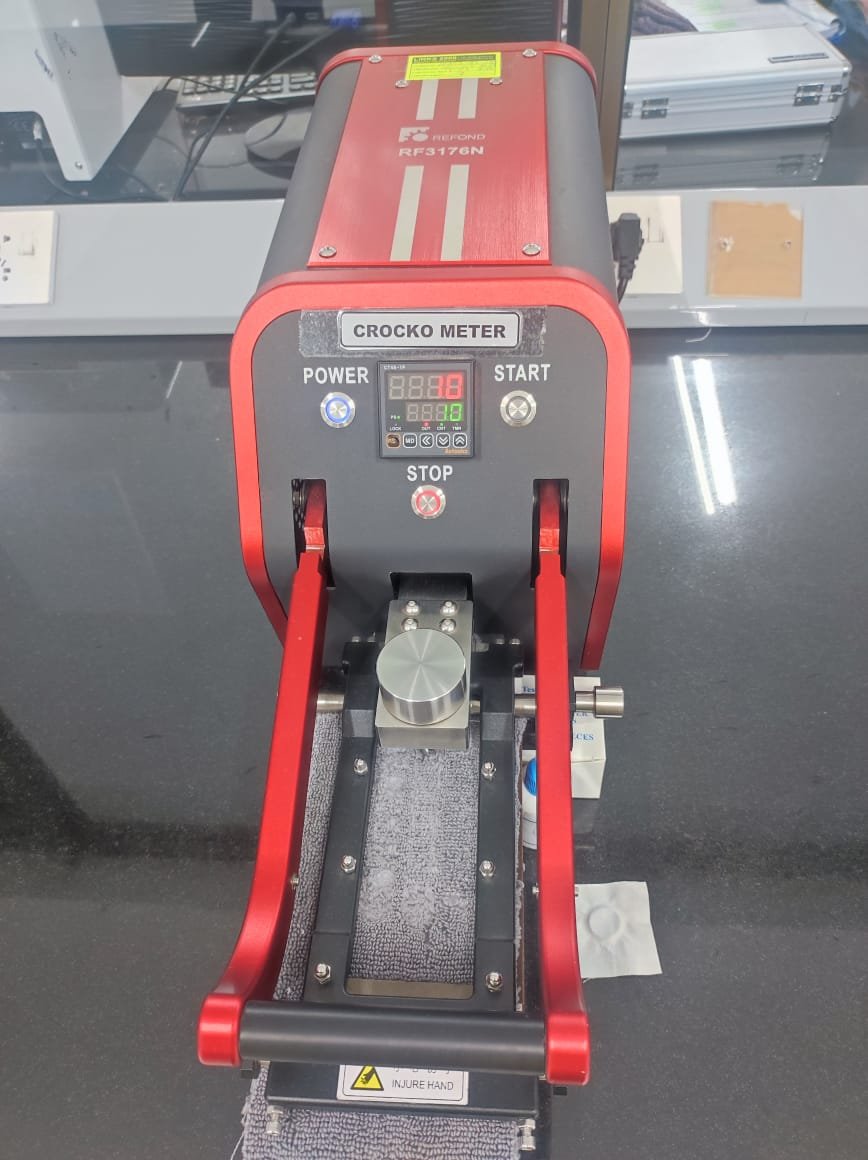
Colorfastness to rubbing is a critical property in the world of textiles and dyes, as it determines how well a fabric or material can withstand friction and abrasion without losing its color. This characteristic is essential for ensuring the longevity and durability of various textile products, from clothing and upholstery to industrial textiles. The evaluation of color fastness to rubbing involves subjecting a material to controlled rubbing or abrasion tests to assess its ability to resist color transfer, fading, or damage caused by repeated friction. This property plays a vital role in maintaining the aesthetic and functional qualities of colored textiles, making it a key consideration in textile manufacturing and quality assurance.
Table of Contents
Tyes of Colorfastness to Rubbing
1-Color Fastness to Dry Rubbin:
This type of rubbing fastness evaluates a material’s resistance to color change or transfer when subjected to dry friction, such as when clothing rubs against another surface or when materials come into contact during storage or handling.
2-Color Fastness to Wet Rubbin:
Wet rubbing fastness assesses the fabric’s ability to retain its color when exposed to moisture, like rain or perspiration. It is especially important for materials used in sportswear or outdoor applications.
the test procedure of Colorfastness to Rubbing:
Equipments and Materials for Colorfastness to Rubbing:
1-ISO Test Method:
ISO 105-X12:2021 is Followed to perform the color fastness for Dry Rubbing.
2-Swatch Dimensions:
Before conducting the color fastness to dry rubbing test, it is essential to prepare swatches of the textile material. ISO recommends using swatches with dimensions of 120 mm x 20 mm (length x width). These swatches should represent the material in question, with the color to be tested.
3-Multifiber Fabric:
The ISO 105-X12:2021 test method employs a multifiber fabric, which consists of various standardized textile fibers. These fibers include cotton, wool, nylon, polyester, and acetate. The choice of the multifiber fabric allows for a comprehensive assessment of color fastness across different fiber types commonly used in the textile industry.
4-Test device/Crockmeter :
The test is typically conducted using a crockmeter, which is a specialized instrument designed for measuring color fastness to dry rubbing. The crockmeter consists of a holder for the swatch, a rubbing finger, and a weight. It is a precision device used to ensure uniform and controlled rubbing during the test.

5-GrayScale :
To evaluate the color fastness, a Gray scale, often referred to as a grayscale or a staining scale, is used. The most commonly employed scale is the ISO 105-A02:1993 scale, which consists of a series of gray color patches. These patches range from pristine white to complete staining, allowing for a visual assessment of the level of color transfer.

Standard Operating procedure For Color Fastness To Rubbing:
- Cut swatches of the textile material to the recommended dimensions of 120 mm x 20 mm.
- Place the swatch securely in the crockmeter holder, ensuring that it is firmly positioned.
- Select a multifiber fabric that closely represents the textile material to be tested.
- The rubbing finger of the crockmeter is wrapped with the multifiber fabric.
- Apply a specific load to the rubbing finger, ensuring consistent pressure.
- Rub the multifiber fabric against the test swatch back and forth for a defined number of cycles, as specified by the ISO standard (e.g., 10 or 20 double rubs).
- After the specified number of rubs, remove the swatch and evaluate it alongside the gray scale.
- Compare the swatch to the grayscale patches to determine the level of color transfer and staining.
- Record the results and assign a colorfastness rating based on the ISO 105-A02:1993 gray scale.
Conclusion:
Conducting the color fastness to dry rubbing test according to ISO 105-X12:2021 provides manufacturers, textile industry professionals, and consumers with a standardized and reliable method to assess the resistance of textile materials to color transfer and fading during dry rubbing. The swatch dimensions, multifiber fabric, machine name (crock meter), grayscale, and detailed procedure outlined in this test method ensure consistent and comparable results, ultimately leading to higher-quality textile products.
Applications of Colorfastness to Rubbing Tests:
Textile Quality Control:
These tests are widely used in the textile industry to ensure that fabrics, terry towels and garments, to maintain their color and appearance during normal wear and washing.
Product Development:
Manufacturers use these tests to develop and improve textile products, ensuring they meet desired colorfastness standards.
Consumer Confidence:
Consumers rely on these tests to make informed purchasing decisions, selecting textiles that retain their color and quality over time.
Regulatory Compliance:
Textile products often need to meet regulatory standards regarding colorfastness, and these tests help ensure compliance.
Performance Assessment:
They are used to evaluate the performance of textiles used in various applications, such as outdoor textiles, sportswear, and uniforms, where colorfastness is crucial.
Frequently Asked Questions (FAQ) on Colorfastness to Rubbing:
Q1: What is color fastness to dry rubbing, and why is it important in the textile industry?
Color fastness to dry rubbing is the measure of a textile material’s ability to resist color transfer and fading when subjected to friction or rubbing. It’s vital in the textile industry as it ensures that products maintain their color and appearance during wear and use, leading to better quality and longer-lasting textiles.
Q2: What is the ISO test method for colorfastness to rubbing, and why is it significant?
The ISO test method for color fastness to dry rubbing is ISO 105-X12:2021. It’s significant because it provides a standardized and internationally recognized procedure for evaluating color fastness, ensuring consistency and reliability in the assessment of textiles.
Q3: What are the recommended swatch dimensions for the colorfastness to Rubbing test?
The recommended swatch dimensions are 120 mm x 20 mm (length x width). These dimensions ensure a consistent and representative sample for testing.
Q4: What is a multifiber fabric, and why is it used in the ColorFastness to Rubbing test?
A multifiber fabric includes various standardized textile fibers such as cotton, wool, nylon, polyester, and acetate. It is used to represent the diversity of fibers commonly used in textiles, allowing for a comprehensive assessment of color fastness across different materials.
Q5: What is the machine used for the Colorfastness to Rubbing test, and why is it necessary?
The machine used for the test is called a crockmeter. It is essential because it provides a controlled and uniform environment for rubbing the multifiber fabric against the test swatch. This ensures consistent and accurate results.
Q6: What is the purpose of the grayscale in the test?
The grayscale, often referred to as a grayscale or staining scale, is used for visual assessment. It consists of a series of gray color patches, ranging from pristine white to complete staining. It helps in determining the level of color transfer and staining, allowing for a standardized evaluation of colorfastness.
Q7: How is the test procedure for colorfastness to Rubbing conducted?
The test procedure involves securing the swatch in the crockmeter, wrapping the rubbing finger with the multifiber fabric, applying a specified load, and rubbing the fabric against the swatch for a set number of cycles. After rubbing, the swatch is evaluated alongside the grayscale to determine the level of color transfer and staining. Results are recorded and rated based on the grayscale.
Q8: What are the benefits of conducting the test according to the ISO standard?
Conducting the test according to the ISO standard ensures consistent and comparable results across the textile industry. It helps manufacturers produce high-quality, durable products and provides consumers with confidence in the colorfastness of their textile purchases.
Q9: What are the possible results for the colorfastness to Rubbing test, and how are they interpreted?
The test results can vary, and they are typically evaluated based on the ISO 105-A02:1993 grayscale. The results can be rated as ‘excellent,’ ‘good,’ ‘fair,’ or ‘poor’ based on the extent of color transfer and staining observed.
Q10: Who can benefit from conducting colorfastness to rubbing tests according to the ISO method?
Manufacturers, textile industry professionals, quality control personnel, and consumers all benefit from these tests. Manufacturers ensure product quality, professionals maintain industry standards, and consumers can make informed purchasing decisions based on the colorfastness of textiles these could be the color fastness to sunlight, color fastness to washing, and color fastness to dry rubbing and we rubbing.
Q11:what is the difference between Color Fastness to Dry rubbing and Wet Rubbing ?.
Color fastness to dry rubbing tests color resistance under dry conditions, whereas color fastness to wet rubbing evaluates resistance to color transfer and fading in wet or moist conditions, typically involving the introduction of moisture during rubbing.
